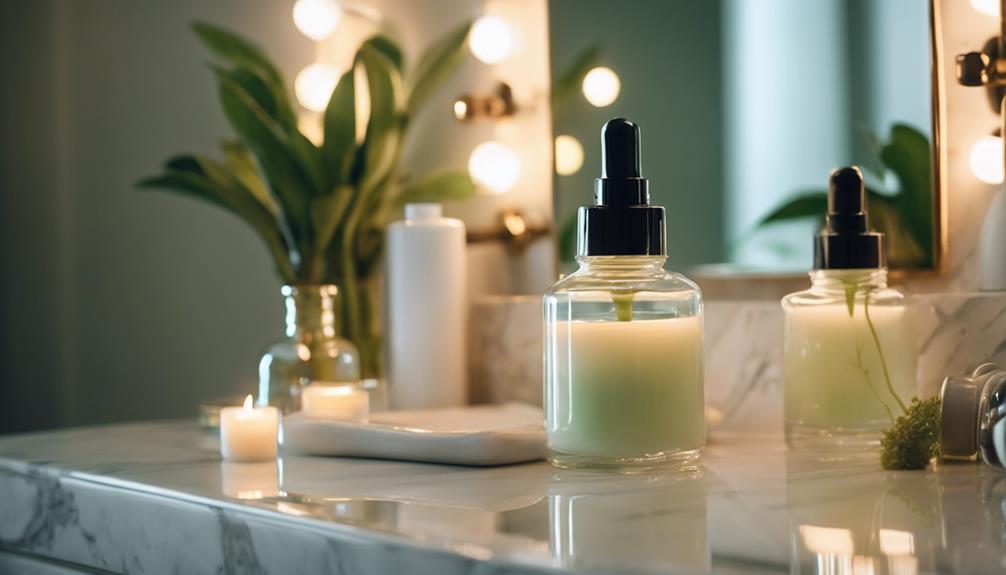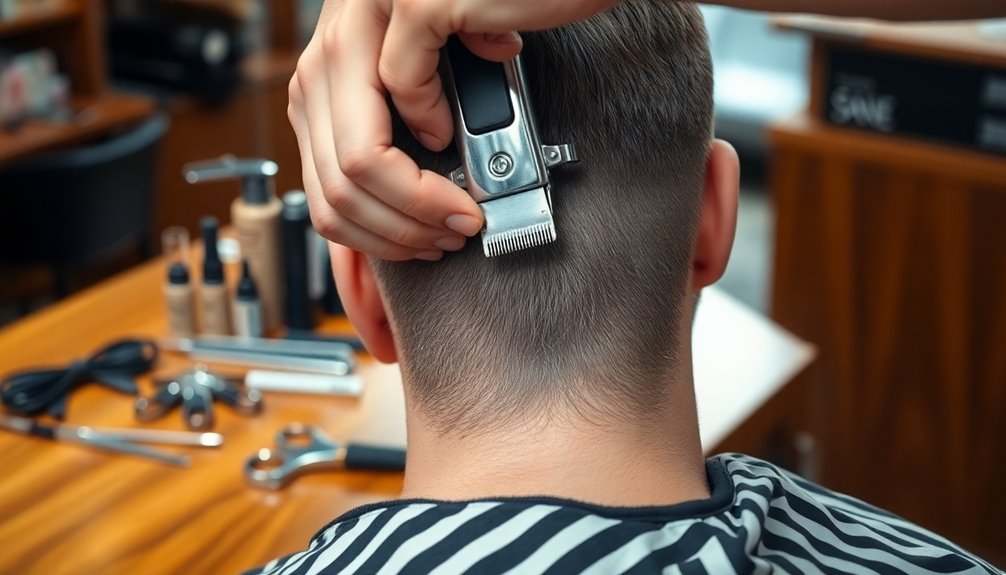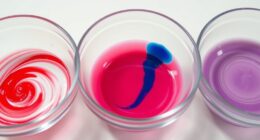Retinol is the perfect solution for combatting signs of aging and achieving smoother skin. It is recommended to start slowly by applying a low concentration twice a week to allow your skin to adjust. Make sure to clean your face and let it dry before using a pea-sized amount. Follow up with a non-comedogenic moisturizer to help lock in hydration. As your skin becomes more accustomed, you can increase usage to every other night. Remember to apply sunscreen during the day, as retinol can increase skin sensitivity to sunlight. Results typically begin to show after about 12 weeks, so be patient. Stay tuned for insider tips on how to maximize your retinol routine for even better results!
Key Takeaways
- Start with a low concentration of retinol, applying it once or twice a week to allow your skin to adjust gradually.
- Cleanse your skin and wait 5-10 minutes before applying retinol to enhance absorption and reduce irritation.
- Follow up with a non-comedogenic moisturizer to maintain hydration and prevent dryness after retinol application.
- Use sunscreen daily, as retinol increases skin sensitivity to UV rays, making sun protection crucial.
Understanding Retinol
Understanding retinol means recognizing its power as a vitamin A derivative that boosts skin cell turnover and tackles signs of aging effectively. This potent ingredient works by increasing collagen production, which enhances skin strength and elasticity. As a result, you'll notice smoother, clearer skin while reducing the appearance of fine lines and wrinkles.
While retinol is highly effective for anti-aging, it's crucial to approach it with caution, especially if you have sensitive skin. Starting with a low concentration helps you gauge how your skin reacts before gradually increasing usage.
To maximize its benefits, apply retinol at night, as it's sensitive to light and can lose potency when exposed to sunlight.
For best results, remember to apply your moisturizer first. This method creates a barrier that can help mitigate potential irritation while still allowing retinol to work its magic.
With consistent use over about 12 weeks, you'll start to see visible results, such as improved skin tone and reduced sun spots. Embrace the power of retinol, and let it transform your skincare routine into an effective anti-aging strategy.
Starting Your Retinol Journey
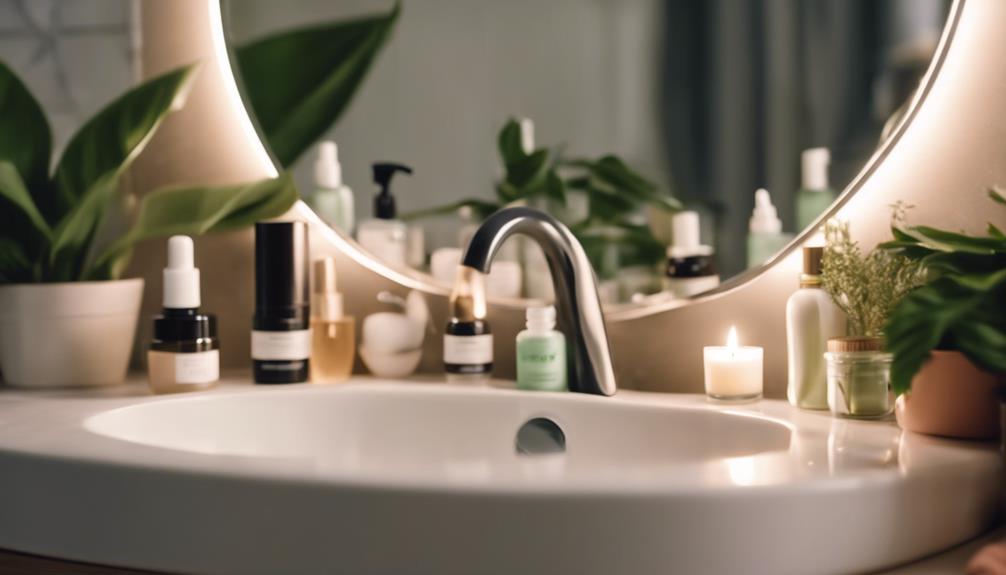
Starting your retinol journey can be exciting, but it's important to approach it with care.
You'll want to understand the benefits of retinol, how to apply it correctly, and how often to use it while adjusting to your skin's needs.
Let's break down the key points to guarantee you get the most out of this powerful ingredient.
Benefits of Retinol
Retinol offers remarkable benefits for your skin, including enhanced texture, reduced fine lines, and a more even tone. This powerful anti-aging ingredient promotes collagen production, which helps your skin become smoother and firmer.
As you incorporate retinol into your routine, you'll notice visible improvements in just about 12 weeks, so patience is key.
Retinol is effective for all skin types, even if you have sensitive skin. It helps clear acne, reduces sun damage, and evens out skin discoloration.
To minimize irritation while starting your retinol journey, consider beginning with a low concentration and gradually increasing the frequency of use. This approach allows your skin to adjust to retinol's potency without overwhelming it.
Application Techniques
To effectively incorporate retinol into your skincare routine, mastering the right application techniques is key.
Begin with clean, dry skin and allow 5-10 minutes post-cleansing for any redness to subside. When you're ready to apply retinol, use a pea-sized amount and distribute it evenly across your face. A quadrant system can help with this: start with your forehead, then move to your chin, and finish with both cheeks.
It's essential to introduce retinol gradually. Start by applying it twice a week, and as your skin adjusts, increase to every other night. This approach minimizes irritation and allows your skin to adapt to the powerful ingredient.
If you're concerned about sensitivity, consider mixing retinol with a moisturizer during the initial weeks. This can create a gentler application while still reaping the benefits of retinol.
Frequency and Adjustment
When you first incorporate retinol into your routine, aim to apply it twice a week to help your skin adjust gradually. This approach minimizes irritation and allows your sensitive skin to adapt. As your skin adjusts, you can increase the frequency to every other night, but listen to your skin's needs.
Keep an eye on how your skin reacts. If you notice any excessive redness or flakiness, cut back on frequency to give your skin time to recover. Remember, patience is key; visible results typically take around 12 weeks to show up.
To enhance your retinol journey, consider these tips:
- Start slow: Gradually increase frequency to avoid overwhelming your skin.
- Monitor reactions: Pay attention to any signs of irritation and adjust accordingly.
- Use skin cycling: Alternate retinol nights with exfoliation to boost tolerance.
Application Guidelines

Applying retinol at night is essential for maximizing its benefits while minimizing the risk of sun sensitivity.
To start your retinol use, cleanse and dry your skin thoroughly. Wait 5-10 minutes to let any redness subside before you apply. Use a pea-sized amount of retinol, distributing it evenly across your forehead, chin, and both cheeks with a quadrant system for thorough coverage.
It's important to introduce retinol gradually into your skincare routine. Begin with using it once or twice a week, allowing your skin type to acclimate before increasing frequency. As your skin adjusts, you can slowly incorporate it more often based on your tolerance.
After applying retinol, always follow up with a non-comedogenic moisturizer. This step helps maintain hydration and counteracts any potential dryness that might occur.
Remember, your skin needs time to adapt, so listen to its signals. If you notice excessive irritation, take a step back and reduce application frequency again until your skin acclimates.
Frequency of Use
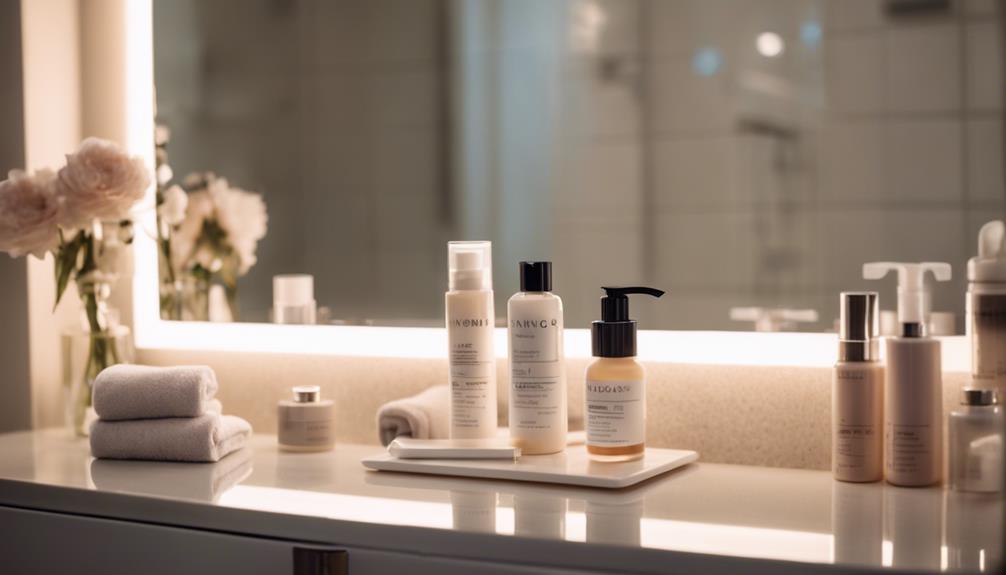
Establishing a consistent frequency for retinol use is key to maximizing its benefits while minimizing irritation. Start with a low-and-slow approach by applying retinol once or twice a week. As your skin adjusts, you can gradually increase to every other night or even nightly. If you have sensitive skin, you might need to wait longer between applications.
To help you stay on track, consider these tips:
- Monitor your skin's response and adjust the frequency of use accordingly.
- Aim for consistent application at the same time each night to build a solid skincare routine.
- Avoid consecutive nights initially to reduce irritation; consider skin cycling by alternating retinol and exfoliating treatments.
Remember to always follow up with a moisturizer after applying retinol to keep your skin hydrated. By being attentive to your skin's needs, you'll achieve the best results while enjoying your retinol journey.
Post-Retinol Care
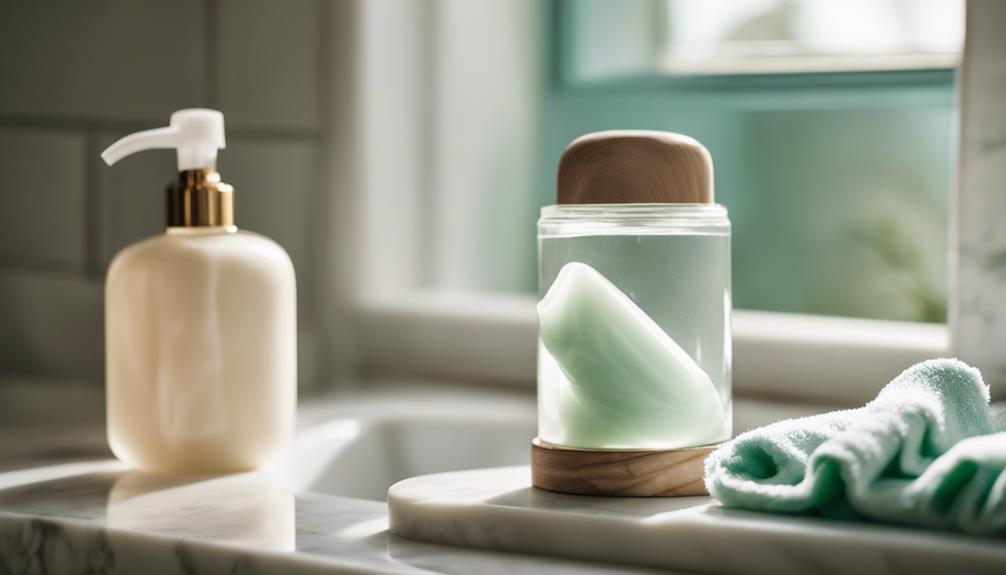
Post-retinol care is vital for guaranteeing your skin remains hydrated and protected after incorporating retinol into your routine. After your retinol application, wait at least 20 minutes before applying any other products. This allows the retinol to absorb properly and helps minimize irritation.
To keep your skin moisturized, choose a non-comedogenic moisturizer that suits your skin type. If you have dry skin, opt for a rich cream; if your skin is oily, a lighter gel will work better. Additionally, consider adding a hydrating serum with ingredients like hyaluronic acid or peptides to enhance moisture and support skin repair.
Be vigilant about monitoring your skin for any signs of irritation. If you notice increased sensitivity or discomfort, adjust your post-retinol care routine by increasing the frequency or amount of moisturizer you use.
Lastly, don't forget to apply broad-spectrum sunscreen during the day. Since retinol can heighten skin sensitivity to UV rays, daily sunscreen is necessary for protecting your skin and maintaining its health.
Common Mistakes to Avoid
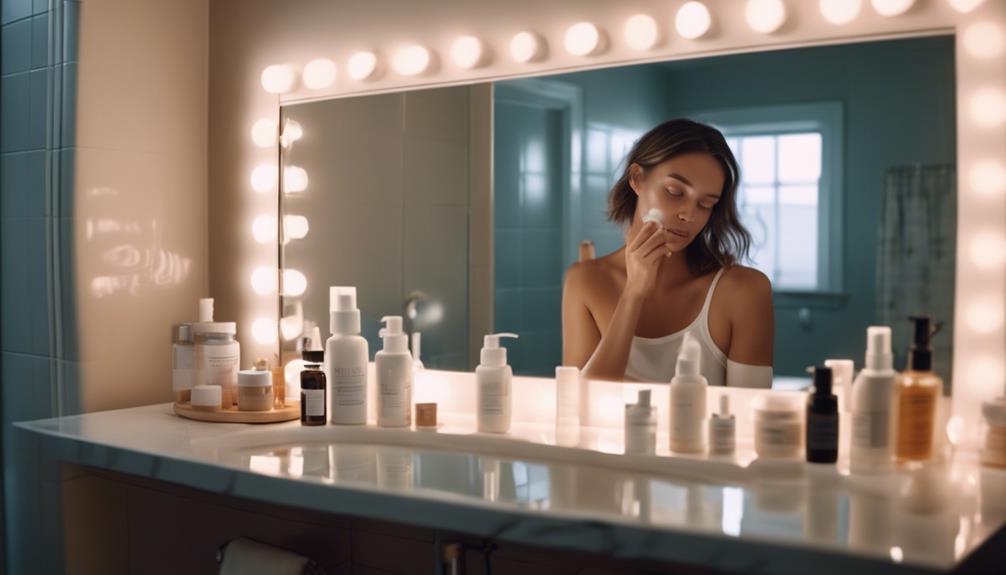
Many people make common mistakes when incorporating retinol into their skincare routine that can lead to irritation and less effective results. To get the most out of your retinol, keep these key points in mind:
Don't start too strong: Jumping in with a high concentration can irritate sensitive skin and lead to discomfort.
Apply moisturizer: Skipping this step after using retinol can leave your skin dry and flaky, counteracting its benefits.
Use sunscreen daily: Failing to protect your skin from the sun can worsen sensitivity and lead to long-term damage.
Watch your frequency: Using retinol too often can cause excessive irritation. Start slow and adjust based on your skin's response.
Recommended Products
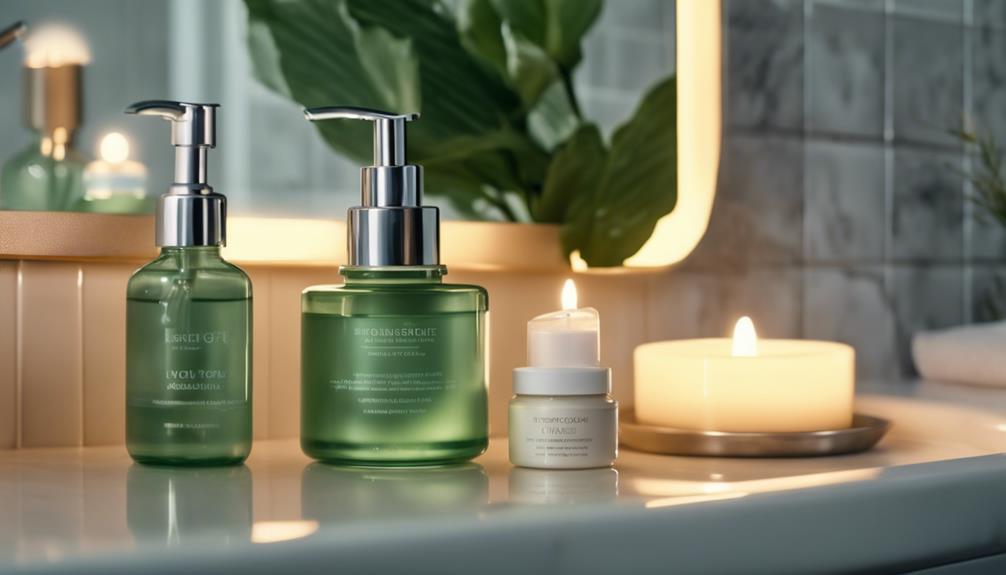
When looking for effective retinol products, it's essential to choose formulations that suit your skin type and concerns.
For those with sensitive skin, La Roche-Posay Redermic R stands out. This lightweight, non-greasy formulation contains 0.1% retinol, targeting signs of aging while improving skin texture without irritation. Another excellent choice is the PCA Skin Retinol Treatment, which has a lower retinol concentration and soothing ingredients, making it perfect for sensitive skin.
If you're new to retinol, consider The Ordinary Retinol 0.2% in Squalane. This affordable option combines retinol with hydrating squalane, providing that vital hydration while you ease into your anti-aging routine.
For a luxury experience, Shani Darden Texture Reform features a blend of retinol and lactic acid, gently exfoliating and improving skin tone.
Lastly, Neutrogena Rapid Wrinkle Repair Retinol Oil combines retinol with nourishing oils, effectively reducing fine lines while keeping your skin hydrated.
Dermatologists recommend these products for their ability to address various skin concerns while promoting a youthful appearance. Choose the one that fits your needs and start your journey toward healthier skin.
Monitoring Skin Changes
Monitoring your skin for changes is essential to tailoring your retinol routine effectively. Regular skin checks help you identify signs of aging and make timely adjustments, ensuring your skincare remains effective. You should keep a journal to track reactions to new products, which can help pinpoint triggers for any skin issues.
Here are a few key points to remember:
- Monitor skin dryness: If you notice increased dryness or irritation, it may be time to adjust your routine.
- Consult with a dermatologist: A professional can provide personalized advice tailored to your skin type.
- Adjust product combinations: If your skin reacts differently with seasonal changes, consider altering how you use your products.
Pay close attention during retinol use, as skin can react differently based on various factors. If you experience significant redness or flakiness, you might need to reduce how often you apply retinol or rethink your product combinations.
Expert Tips and Insights
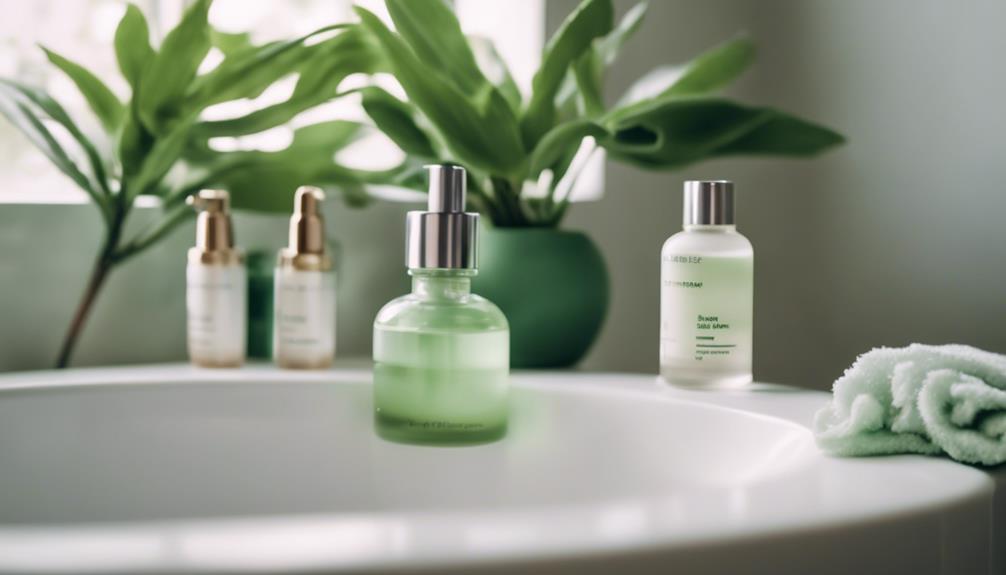
When it comes to retinol, choosing the right product for your skin is essential.
You should introduce it gradually to avoid irritation and keep an eye on how your skin reacts as you adjust the frequency.
With these expert tips, you'll be well on your way to achieving the best results from your retinol routine.
Personalized Retinol Selection
Choosing the right retinol product hinges on understanding your unique skin type and concerns. If you have sensitive skin, starting with a lower concentration, like 0.2% or 0.5%, is essential to minimize irritation. For those with dry skin, a cream-based formulation works best, while oily skin types may prefer a lightweight retinol serum or gel.
Here are some key factors to take into account when selecting your retinol:
- Look for hydrating ingredients like hyaluronic acid to combat dryness.
- Choose products in dark or opaque packaging to maintain potency.
- Reflect on your skin's specific needs; a dermatologist can offer tailored advice.
Gradual Introduction Strategy
To ease your skin into a retinol routine, start by applying the product just once or twice a week. This gradual introduction allows your skin to acclimate without overwhelming it. Choose a lower concentration of the active ingredient, like 0.2%, to minimize irritation and dryness as you begin.
As you apply retinol, consider a buffering technique: use a moisturizer before and after applying the retinol. This method helps reduce sensitivity and keeps your skin hydrated. Pay attention to how your skin reacts; if it gets too sensitive, don't hesitate to adjust how often you apply the retinol.
Once your skin can handle the initial frequency, gradually increase it to every other night. Consistency is key; over time, you'll notice visible improvements in skin texture and a reduction in fine lines, usually after about 12 weeks.
Monitoring Skin Reactions
Monitoring your skin for irritation is essential during your retinol journey, as it helps you make informed adjustments to your routine. Regularly check for signs of skin irritation, especially in the initial weeks of retinol use. Keeping a skincare journal is a great way to track your skin's reactions and note any changes in skin texture over time.
Here are some tips to help you monitor your skin reactions effectively:
- Watch for redness: A little pink is normal, but excessive redness can signal irritation.
- Note flakiness: Some dryness is expected, but severe flaking might mean you need to ease up.
- Adjust application frequency: If irritation occurs, consider reducing how often you apply retinol.
Be patient with your skin. Noticeable improvements from consistent use typically take 12 weeks or longer. By monitoring your skin reactions and making necessary adjustments, you'll be on your way to achieving that youthful glow you desire.
How Does Tretinoin Compare to Retinol in an Anti-Aging Skincare Routine?
When comparing tretinoin to retinol in an anti-aging skincare routine, it’s important to note that tretinoin is stronger and more effective at reducing fine lines, wrinkles, and hyperpigmentation. However, it can also cause more irritation and dryness compared to retinol. Adjust your skincare routine with tretinoin accordingly.
Conclusion
Incorporating retinol into your skincare routine can feel like revealing the fountain of youth!
With its magical anti-aging powers, you'll be turning back the clock faster than a time machine.
Remember to start slow, listen to your skin, and follow our tips like they're the secret recipe to eternal youth.
Before you know it, you'll be glowing like you just walked off a Hollywood red carpet!
Embrace the journey, and watch your skin transform into pure perfection!
